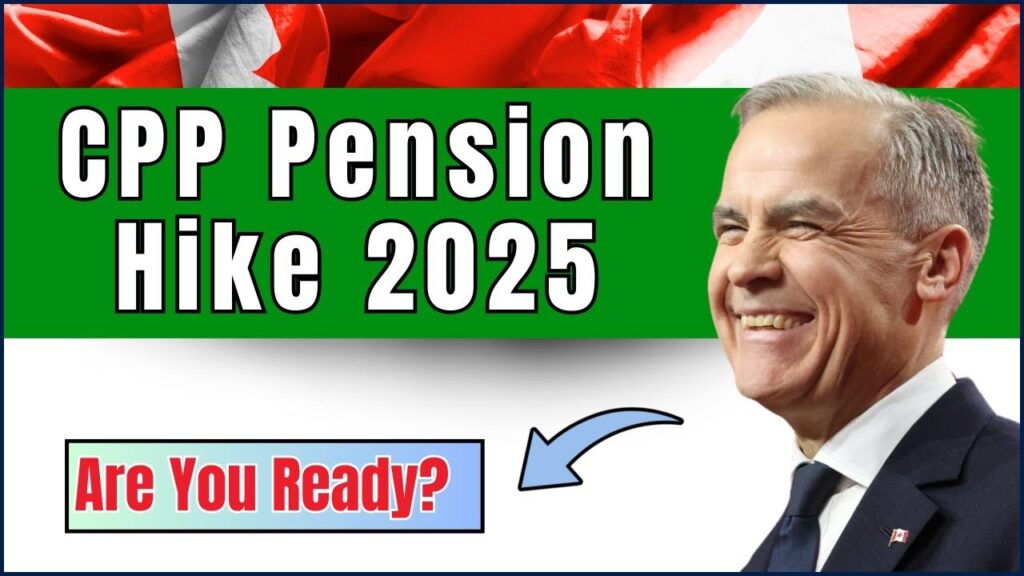CPP Pension Hike 2025: The CPP Pension Hike 2025 is officially underway, bringing with it some of the most impactful changes to Canada’s retirement landscape in recent years. If you contribute to the Canada Pension Plan (CPP), are already receiving benefits, or plan to retire in the next decade, understanding these updates is crucial. These enhancements will affect your paycheck today and your pension payouts tomorrow.

So, what exactly does this mean for you? In this comprehensive guide, we’ll break down the latest 2025 changes, why they’re happening, how much more you’ll contribute, and how you can plan strategically to make the most of your retirement years.
Canada’s government continues to evolve public retirement programs like the CPP to ensure they remain sustainable and effective. With the population aging, inflation rising, and Canadians living longer than ever, it’s essential that pension plans provide enough income to support retirees through a potentially lengthy retirement.
CPP Pension Hike 2025
| Topic | Details |
|---|---|
| Monthly CPP Increase | Up to $1,433 maximum per month |
| Average Monthly CPP Payment | Around $808.14 |
| CPP Contribution Rate | 5.95% (employee), 11.9% (self-employed) on earnings up to $71,300 |
| Additional Contribution | 4% on earnings between $71,300 and $81,200 |
| CPP Enhancement Goal | Increase replacement income to 33.33% |
| One-Time OAS Top-Up | $650 (March 2025) |
| Next Payment Dates | April 28, May 29, June 26, 2025 |
| Official Website | canada.ca |
The CPP Pension Hike 2025 is more than just a numbers game – it’s a strategic step toward a more secure retirement for all Canadians. By paying a little more into the system today, workers can look forward to more reliable income later in life.
These updates reflect changing demographics and financial realities. Whether you’re early in your career or nearing retirement, understanding how CPP works and how to plan around it is vital. Take the time to review your situation, learn about your options, and make use of tools and resources available through the government.
What Is the CPP Pension Hike 2025 All About?
In plain terms, the CPP Pension Hike 2025 means you’ll contribute more during your working years to receive higher retirement benefits. This isn’t just a random increase—it’s part of a larger, well-planned rollout of the CPP enhancement, which began in 2019 and is now entering its final phases.
The purpose? To ensure Canadians can count on a more reliable and sufficient retirement income from the public pension system. With many workers facing dwindling workplace pensions and uneven personal savings, an enhanced CPP becomes a more critical pillar of retirement planning.
Why Is This Change Happening?
Several major social and economic factors are driving the need for these changes:
- Canadians are living longer. In fact, many retirees are now spending 25-30 years in retirement, making longevity planning more important than ever.
- Cost of living is climbing. From groceries to housing to healthcare, seniors need more income to keep up with daily expenses.
- Private pensions are declining. Fewer companies offer defined benefit pension plans, and self-employed workers are more reliant on government benefits.
These realities have pushed policymakers to improve CPP benefits by gradually raising contribution levels while increasing the potential payout. This gradual approach ensures minimal disruption to take-home pay while still improving retirement outcomes over time.
How Much More Will You Pay into CPP in 2025?
Here’s a detailed breakdown of the updated contribution rules so you can see what to expect based on your earnings level:
Base Contributions (Up to $71,300)
- Employees contribute 5.95% of their pensionable earnings.
- Employers match this contribution.
- Self-employed individuals pay both shares, totaling 11.9%.
Second Tier Contributions (From $71,300 to $81,200)
Introduced as part of the final phase of CPP enhancement, this new tier ensures higher earners contribute more:
- Employees contribute an additional 4%.
- Employers match this amount.
- Self-employed individuals again pay both portions, for a total of 8%.
Example Scenario: Imagine you earn $80,000 in 2025. Your base CPP contribution would be approximately $4,140, including the additional contributions from the second tier.
These new thresholds may seem complex, but they are designed to more accurately reflect modern earnings patterns, especially for middle- and high-income earners who previously topped out under the older system.
How Much Will You Receive from CPP in 2025?
The amount you receive from CPP depends on your average lifetime earnings, how long you’ve worked, and when you start collecting your benefits.
Here are the key figures:
- Maximum Monthly CPP: $1,433 (if you contributed the maximum for 39+ years)
- Average Monthly CPP: $808.14 (based on new retirees starting at age 65)
Factors That Affect Your CPP Amount:
- Contribution history: Consistency matters. Gaps in employment or lower income years reduce your average.
- Start date: Starting earlier gives you smaller monthly payments. Delaying up to age 70 can increase your benefit by up to 42%.
Planning when to start taking CPP is a big decision. Many Canadians choose to take it at 65, but some choose earlier or later depending on health, need, and other income sources.
What Is the CPP Enhancement?
The CPP enhancement is a government-led initiative to increase retirement security for working Canadians. It is a phased upgrade of the original plan, with two main improvements:
- Increasing the income replacement level from 25% to 33.33%.
- Raising the maximum annual earnings covered by CPP contributions.
Why It Matters:
In the past, CPP only replaced about a quarter of a worker’s average earnings. The enhancement aims to increase that to one-third, giving retirees a more comfortable and stable income. It’s especially important for Canadians who may not have large RRSPs or employer-sponsored pensions.
New workers entering the job market post-2019 will see the biggest benefit, but even those already contributing will notice improvements over time.
What About OAS? Extra Boost in 2025
In addition to the CPP changes, the federal government introduced a $650 one-time top-up to Old Age Security (OAS) in March 2025. This was designed to provide short-term relief in the face of high inflation, which has significantly impacted seniors on fixed incomes.
OAS is separate from CPP but works hand-in-hand as a major income source for most Canadian retirees. Eligibility is based on residency in Canada, and payments are automatically adjusted quarterly based on inflation.
For more information or to check eligibility, visit the OAS section on Canada.ca.
How Can You Maximize Your CPP Benefits?
1. Delay Taking CPP
Waiting past age 65 can increase your monthly payment. For every month you delay (up to age 70), your benefit increases by 0.7%, for a total of 42% more by age 70.
2. Keep Working and Contributing After Age 65
Even if you start receiving CPP, you can continue working and contributing. These extra contributions go toward the Post-Retirement Benefit (PRB), giving you additional income boosts.
3. Use My Service Canada Account
Stay on top of your contributions by checking your My Service Canada Account. It lets you view your CPP contribution history, estimate future benefits, and manage your application.
4. Coordinate with Other Income Sources
Look at your RRSPs, TFSAs, private pensions, and OAS together. Properly timing withdrawals and combining income sources can reduce taxes and optimize your retirement income.
5. Get Professional Advice
A financial advisor can help tailor your CPP strategy based on your health, goals, and financial needs. They can also help you model different scenarios based on your retirement age.
$2,350 OAS Boost for Seniors in Canada 2025: Check Eligibility Criteria!
Canada Express Entry New Rules 2025: Check New Application Process and Eligibility Criteria
Canada’s CRA Payment Increase in April 2025 – Check Updated Benefit Amount!
FAQs On CPP Pension Hike 2025
When will the next CPP payments arrive?
The next CPP direct deposit dates are:
- April 28, 2025
- May 29, 2025
- June 26, 2025
Is the CPP taxable?
Yes. CPP is considered taxable income and must be included in your income tax return. You can ask Service Canada to withhold taxes monthly.
Can I receive CPP and OAS together?
Yes, most Canadians receive both. They are separate programs with separate eligibility rules.
How do I apply for CPP?
Apply through your My Service Canada Account or by mailing in a completed application form.
Does delaying CPP always make sense?
It depends on your financial situation, expected lifespan, and personal goals. If you expect to live well into your 80s or 90s, delaying can provide more income over time.
Can CPP be split with a spouse?
Yes. You may be eligible to split CPP benefits with your spouse or common-law partner to reduce overall taxes.








